Blois is the capital of Loir-et-Cher department in central France.
Blois may also refer to:
- Blois family, major landowners in Suffolk
- Blois Football 41, a French football club
- Château of Blois, a Château in the city of Blois
Blois is the capital of Loir-et-Cher department in central France.
Blois may also refer to:
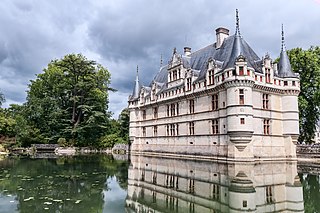
The Loire Valley, spanning 280 kilometres (170 mi), is a valley located in the middle stretch of the Loire river in central France, in both the administrative regions Pays de la Loire and Centre-Val de Loire. The area of the Loire Valley comprises about 800 square kilometres (310 sq mi). It is referred to as the Cradle of the French and the Garden of France due to the abundance of vineyards, fruit orchards, and artichoke, and asparagus fields, which line the banks of the river. Notable for its historic towns, architecture, and wines, the valley has been inhabited since the Middle Palaeolithic period. The oldest known Neanderthal engravings have been found a cave in La Roche-Cotard which have been dated to more than 57,000 years ago. In 2000, UNESCO added the central part of the Loire River valley to its list of World Heritage Sites.

The Château de Cheverny is located in Cheverny, Loir-et-Cher, France. It is one of the châteaux of the Loire Valley.
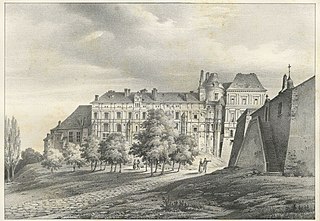
The Royal Château of Blois is a château located in the city center of Blois, Loir-et-Cher, in the Loire Valley, France. In addition to having been the residence of the Counts of Blois and some French Kings, Joan of Arc also went there by 1429 to be blessed by the Archbishop of Reims before departing with her army to drive against the English, who conquered Orléans the previous year.

The Château de Chaumont, officially Château de Chaumont-sur-Loire, is a castle (château) in Chaumont-sur-Loire, Centre-Val de Loire, France. The castle was founded in the 10th century by Odo I, Count of Blois. After Pierre d'Amboise rebelled against Louis XI, the king ordered the castle's destruction. Later in the 15th century Château de Chaumont was rebuilt by Charles I d'Amboise. Protected as a monument historique since 1840, the château was given into state ownership in 1938 and is now open to the public.
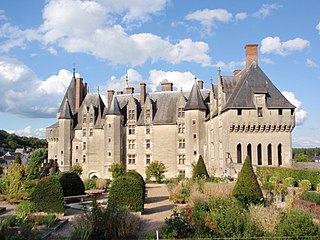
The Château de Langeais is a 15th-century Flamboyant Gothic castle in Indre-et-Loire, France, built on a promontory created by the small valley of the Roumer River at the opening to the Loire Valley. Founded in 992 by Fulk Nerra, Count of Anjou, the castle was soon attacked by Odo I, Count of Blois. After the unsuccessful attack, the now-ruined stone keep was built; it is one of the earliest datable stone examples of a keep. Between 994 and 996, the castle was besieged unsuccessfully twice more. During the conflict between the counts of Anjou and Blois, the castle changed hands several times, and in 1038 Fulk captured the castle again.
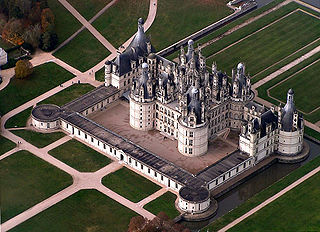
The Château de Chambord in Chambord, Centre-Val de Loire, France, is one of the most recognisable châteaux in the world because of its very distinctive French Renaissance architecture, which blends traditional French medieval forms with classical Renaissance structures. The building was constructed by the king of France, Francis I.
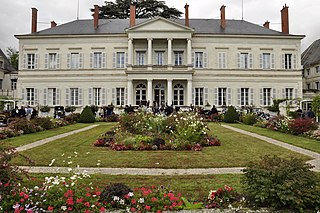
Loir-et-Cher is a department in the Centre-Val de Loire region of France. Its name is originated from two rivers which cross it, the Loir in its northern part and the Cher in its southern part. Its prefecture is Blois. The INSEE and La Poste gave it the number 41. It had a population of 329,470 in 2019.

Blois is a commune and the capital city of Loir-et-Cher department, in Centre-Val de Loire, France, on the banks of the lower Loire river between Orléans and Tours.
Clermont may refer to:

The châteaux of the Loire Valley are part of the architectural heritage of the historic towns of Amboise, Angers, Blois, Chinon, Montsoreau, Orléans, Saumur, and Tours along the river Loire in France. They illustrate Renaissance ideals of design in France.
Sully may refer to:
Rouge is the French word for "red" and may refer to:
Theobald is a Germanic dithematic name, composed from the elements theod- "people" and bald "bold". The name arrived in England with the Normans.
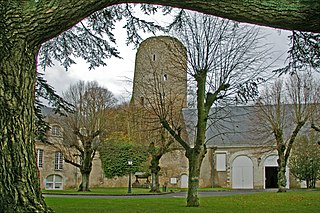
Château-Renault is a commune in the Indre-et-Loire department in central France.

Chaumont-sur-Loire, commonly known as Chaumont, is a commune and town in the Loir-et-Cher department and the administrative region of Centre-Val de Loire, France, known for its historical defensive walls and its castle.

Fréteval is a commune in the French department of Loir-et-Cher. The village is located on the right bank of the river Loir. Archaeological evidence indicates that the site was occupied by the second century CE. In the Middle Ages, the fortifications of the Château de Fréteval were used to defend the region against Anjou and, later, England. The Battle of Fréteval was fought nearby in 1194. The Forest of Fréteval extends into the northern part of the commune and was used in World War II as a refuge for Allied airmen shot down over France.

Gardens of the French Renaissance were initially inspired by the Italian Renaissance garden, which evolved later into the grander and more formal jardin à la française during the reign of Louis XIV, by the middle of the 17th century.
François Fénelon (1651-1715) was Archbishop of Cambrai, a French writer and theologian.
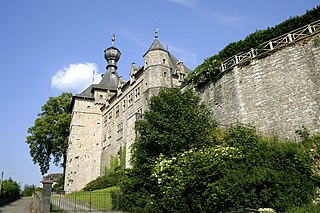
Chimay Castle is a château in Chimay, Hainaut, Wallonia, Belgium. The castle has been owned by the Prince of Chimay and his ancestors for centuries, and it is open to the public for tours during part of the year. Although the castle was significantly damaged by a fire in 1935, the structure was subsequently rebuilt, and renovations continue under the current generation of the princely family.

The Hôtel d'Alluye is an hôtel particulier in Blois, Loir-et-Cher, France. Built for Florimond Robertet when he was secretary and notary to Louis XII, the residence bears the name of his barony of Alluyes. On Rue Saint-Honoré near Blois Cathedral and the Château de Blois, it is now significantly smaller than it was originally as the north and west wings were destroyed between the seventeenth and nineteenth centuries.